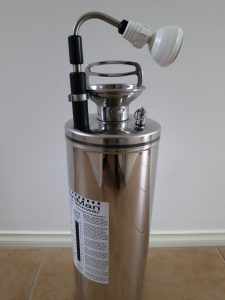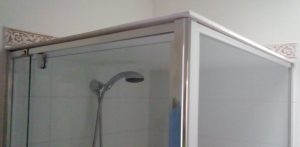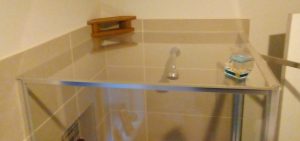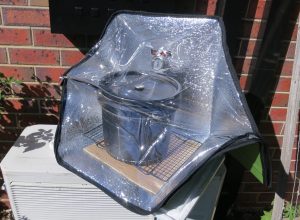We developed a solar hot water system that’s easy to move, requires no installation and will work in almost any shower. All you need is an outdoor space that, on a sunny day, gets at least 4 hours of direct sun. Here’s how we did it in three simple steps:
- Pump shower
We bought a RainMan pump shower that is manufactured in Australia and ships internationally [1]. It is simple, durable, and uses 12 litres of water to deliver a 5 minute shower.
Full of water, it weighs a little over 12kg so it is easy enough to move around. We have used this unit for over a year now and it has worked well.
Solar hot water is poured into the pump shower and then mixed with cold water or hot water (on a cloudy day) to get the desired temperature which is shown on the side of the unit.
At the beginning of a shower, you extend the shower head up (which is contained in the pump shower) and the unit is pumped up 8-10 times and then during the shower at certain intervals it is pumped up again to keep the pressure up.

- Portable solar hot water heater
To heat water with the sun, we use a way that is easy to set up and cheap to buy: a portable solar oven. We use two SunFlair solar ovens with a 10 litre bucket inside each of them.
The buckets are food grade buckets with lids and can be collected for free from restaurants. They have been spray painted mat black on the outside.
Because the best location for sun changes over the course of the year, these solar ovens can be easily put in the best location.
In summer, it takes 2-4 hours to get a bucket of water to 42 degrees depending on cloud cover while in full sun in winter it takes 4 to 5 hours.
To make the most of your portable solar hot water system, it’s best to use the water in the afternoon or evening. If you cover your bucket with a blanket, it will only lose 1-2 degrees per hour.
To avoid the risk of legionella bacteria breeding in stagnate warm water over time, we fill the bucket in the morning, heat it over the day and if the water is not used that evening or the next morning, it is used straight away in the washing machine, toilet or garden.
If the water is under 40 degrees, we just use a full kettle or two to make up the difference depending on the time of year or we add cold water if the solar water is above 42 degrees.
- Seal the shower

To make a shower comfortable with 2.5 litres/min of hot water, we have sealed the top of the shower.
Sealing a shower cubicle makes the showering experience much more comfortable for showering and drying off by trapping in the heat from the shower water which eliminates the need for bathroom heating in winter. It also prevents moisture from entering the bathroom [2].
To dry out the shower and to prevent mould, simply leave the door open at the end of your shower.
As long as you have a shower cubicle, just use a lightweight, waterproof material cut to size that can rest on top and if necessary, one or two adhesive hooks can be used on the tiles to support the side of shower roof that is not supported by the cubicle.
We use an insulated plastic panel that was saved from going to landfill though any lightweight material like perspex or the material used in real estate or campaign signs would also work well. Glass is not recommended due to its weight and risk of breakage.
Adhesive hooks will not leave a trace when secured to tiles and the roof can easily be removed when need be. By the way, this actually works really well even if you plan to continue using your hot water unit.

The Result
Given that our solar system meets at least half of our energy needs, this drops our system down to 0.3kWh for the two of us. This is just 5% of what the average Australian household uses for hot water energy.
Unless you live in a region that gets regular sun all year round, this system works best with non-daily showering habits as it takes around 5-10 minutes to heat back up water with a kettle for a shower which might be a hassle for daily showerers.
For the little bit of added effort, this system can also function during sunny weather if there’s a power or gas supply interruption or all weather if you have a back-up source of heating (like a hiking stove, wood stove or outdoor gas burner).

How much does it cost?
The system cost us $350 for the pump shower and $260 for the two solar ovens, a total of $610 for the whole system.
The first solar oven was purchased with included cookware for $200 while the second one was purchased for $30 plus $30 postage from Ebright energy in New Zealand as we didn’t need the cookware for the second oven [3].
You can cut the price down by purchasing an electric camp shower instead of the pump shower we use and two solar ovens without cookware. Doing it this way, you could put together the same system for $200.
This system should save you $70-$200 a year if you have a gas hot water unit (depending on where you live) and $270 a year if your hot water unit is electric. If this system is used with an induction cooker plus a split system unit for heating, then you can save more by going gas free.
Further Reading:
[1] We have listed this product because there are not many pump showers around and we haven’t found anything of this quality:http://www.rainmancampshower.com.au/
[2] http://www.sunfrost.com/energy_efficient_shower.html[3] Finding a SunFlair oven in Australia is not hard but finding someone willing to sell it without the cookware or trays is very difficult. We do use our first solar oven for cooking at times but the second unit is only for hot water so we didn’t want a second set of cookware. This company from New Zealand happily sold us a unit with just a temperature gauge: